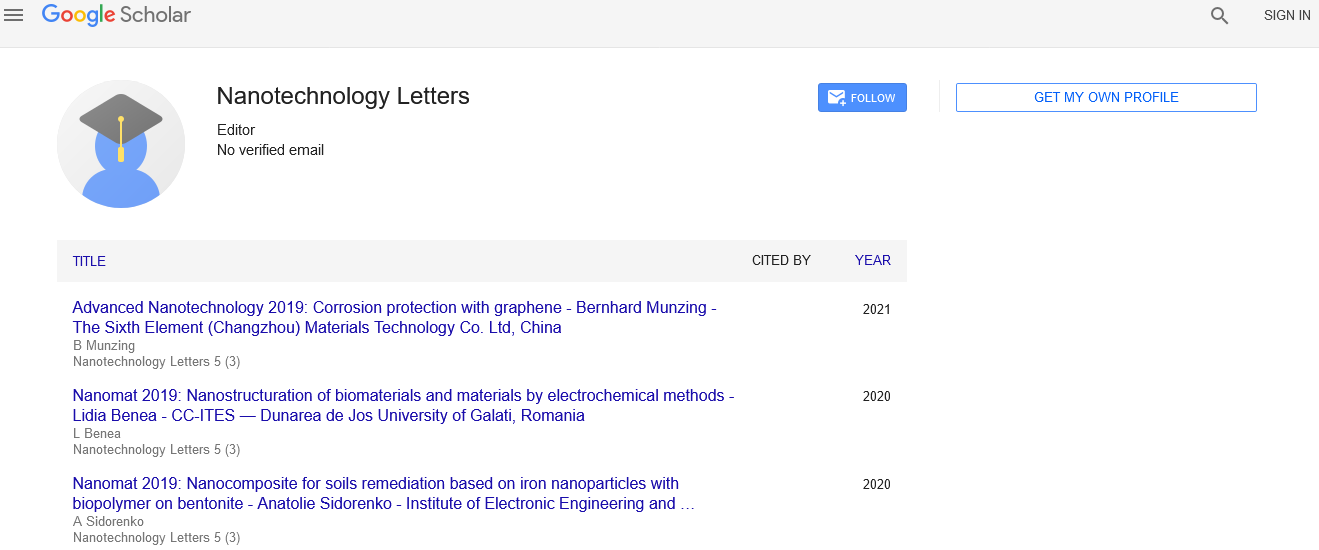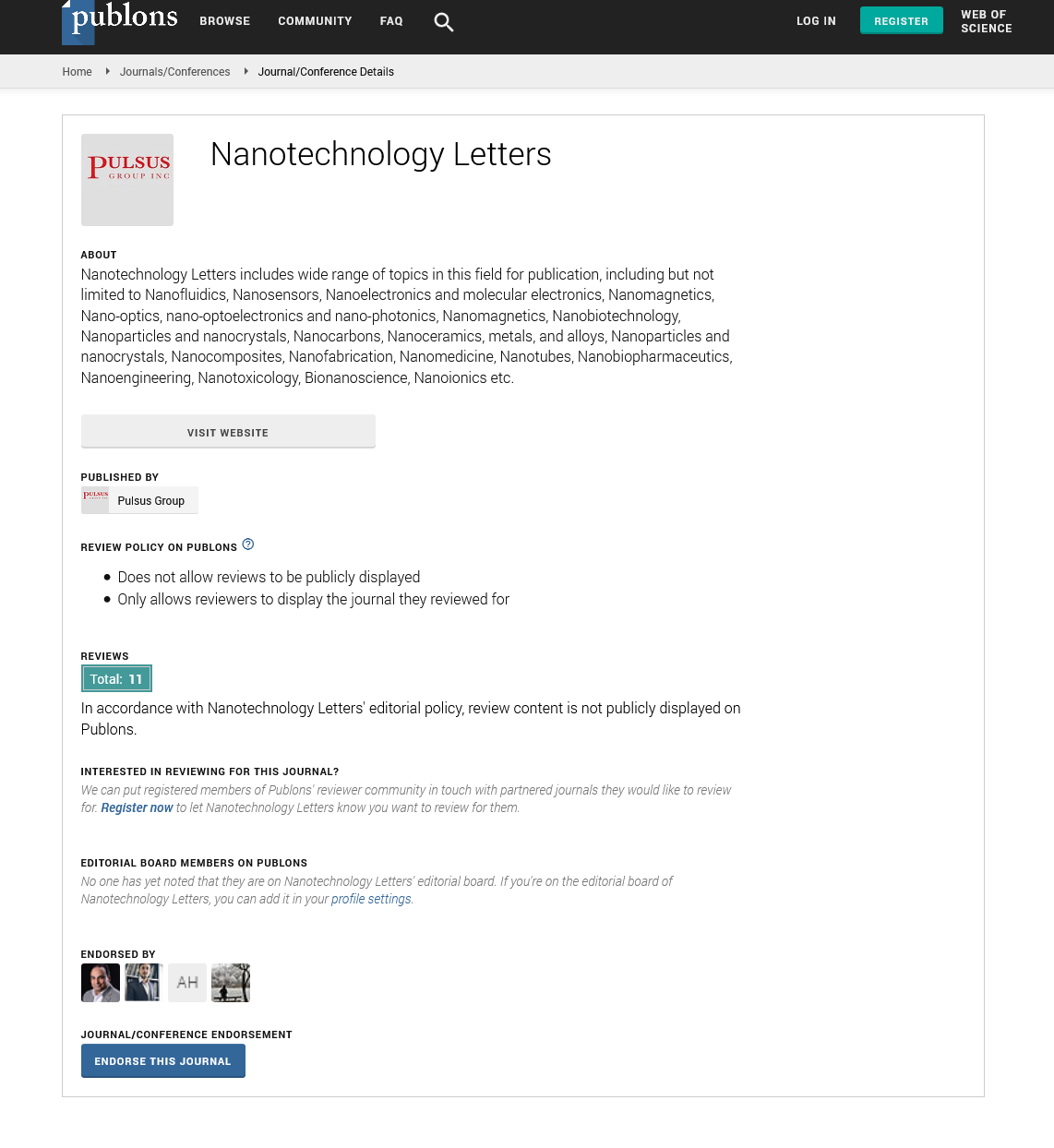Fabrication of titanium and aluminum based materials through in situ selective laser melting of reactive composites
Received: 03-Mar-2023, Manuscript No. pulnl-23-6766; Editor assigned: 09-Mar-2023, Pre QC No. pulnl-23-6766 (PQ); Accepted Date: Mar 27, 2023; Reviewed: 15-Mar-2023 QC No. pulnl-23-6766 (Q); Revised: 20-Mar-2023, Manuscript No. pulnl-23-6766 (R); Published: 28-Mar-2023, DOI: 10.37532. pulnl.23.8 (2) 27-28
Citation: Lockwood E. Fabrication of titanium and aluminum based materials through in situ selective laser melting of reactive composites. Nanotechnol. lett.; 8(2):27-28
This open-access article is distributed under the terms of the Creative Commons Attribution Non-Commercial License (CC BY-NC) (http://creativecommons.org/licenses/by-nc/4.0/), which permits reuse, distribution and reproduction of the article, provided that the original work is properly cited and the reuse is restricted to noncommercial purposes. For commercial reuse, contact reprints@pulsus.com
Abstract
Additive Manufacturing (AM) of refractory materials necessitates either a substantial laser power or the utilization of various easily fusible binders. In this study, we present an alternative approach involving the utilization of spherical reactive composite particles composed of Ti and Al. These particles are acquired through high-energy ball milling prior to use. Employing these powders, we achieved the production of hightemperature TiAl-based materials through the Selective Laser Melting (SLM) technique. Upon laser heating, the composite particles, which have been mechanically activated, swiftly undergo a reactive process, liberating a substantial amount of heat and transforming into corresponding intermetallic compounds. The ignition of this combustion reaction can be initiated at relatively low temperatures, and the exothermic effect serves to prevent abrupt cooling of the tracks formed during sintering. This methodology enables the creation of dense intermetallic materials possessing a uniform structure in a single step via SLM, obviating the requirement for high-powered lasers, binders, or supplementary post-processing and heat treatments.
Key Words
Titanium aluminides; High-energy ball milling; Microstructure; Selective laser melting; Nanotechnology
Introduction
Additive Manufacturing (AM), also referred to as 3D printing or selective laser printing, is a swiftly advancing method that possesses the ability to craft a diverse array of structures and intricate geometries by employing laser-driven printing to build successive material layers atop one another. Governed by computer commands, the final structure adheres to the original Computer-Aided Design (CAD) model [1]. This approach facilitates the creation of intricate shapes and configurations without resorting to casting, machining, or subsequent labor-intensive and costly post-processing steps. These advantages are particularly significant when producing components featuring internal voids and pathways. The existing AM techniques can be broadly categorized into two subgroups: (1) powder bed fusion; (2) directed energy deposition. In powder bed fusion, a layer of powdered material with defined thickness is deposited on the work surface and then selectively treated with a laser, leading to the consolidation or melting of the supplied powder and the formation of the intended structure. In directed energy deposition, there's no preliminary layering; instead, material is introduced to a specific location along with the application of energy. Each method possesses distinct strengths and limitations, contingent upon the particulars of the processes and materials employed. Powder bed fusion techniques have gained substantial traction due to their superior precision and extensive range of potential applications [2].
Titanium-based alloys and intermetallics are advanced materials widely employed across diverse industries. When intricate or customshaped components need to be manufactured, 3D printing presents significant economic advantages through cost and waste reduction. Furthermore, the conventional furnace-based production of titanium aluminides is intricate due to the dissimilar densities, melting and boiling points of titanium and aluminum, along with the pronounced affinity of both Ti and Al for oxygen and nitrogen. Consequently, the melting and casting of TiAl, as well as 3D printing processes, demand operation within a protective atmosphere or vacuum conditions. These complexities extend to the additive manufacturing of TiAlbased alloys as well. As the initial material for Selective Laser Melting (SLM) is in powder form, the atomization of powders from pre-cast or fused precursors also necessitates a safeguarding environment. Additionally, titanium aluminides exhibit brittleness at room temperature and are susceptible to the development of microcracks during SLM [3]. Furthermore, the melting of titanium aluminide powders mandates heating to temperatures ranging from 1400 â?¦ C to 1500 â?¦ C, contingent upon composition, which mandates the use of a potent laser.
The challenge of traditional manufacturing methods
To summarise, ugly individuals receive less assistance, are rejected, are seen to be morally or socially unfit, and are generally lacking in personality and worth. To mitigate some of these drawbacks, the function of cosmetics and aesthetic tools in boosting the more favourable elements of appearance, with or without probable plastic surgical operations, is seen as critical. This research suggests employing a smart carrier consisting of non-woven tissues infused with antioxidant compounds to try to improve the look of aged skin.
Skin
Skin, the biggest human organ, accounts for 12%-15% of body weight and has a surface area of 0.5 m2 and a thickness of less than 3 mm. The epidermis, together with the Stratum Corneum (SC), constitutes the body's outer coating, forming a self-repairing and constantly replenished water and antioxidant barrier [4].
As a result, it appears to be the body's first line of defence against environmental aggressions, preventing water loss and penetration by damaging agents such as sun UV radiation and air nano-particulates . As a result, skin is a complex and dynamic organ that is in contact with the environment and ages as a result of its hostile agents [5].
However, skin becomes increasingly susceptible as it ages, as numerous naturally protective activities decline: tissues degenerate slowly and irreversibly, as seen first and foremost by fine lines and wrinkles of the face and neck [6]. Desire for eternal beauty therefore plays a vital part in modern culture, which means that both men and women are seeking for therapies to avoid skin ageing phenomena via the use of novel rejuvenation products and procedures.
Skin dressing
Some writers believe that bio-functional non-woven tissues should be manufactured as novel textiles made of biologically active materials with smart biological features.
They must, in fact, maintain the skin and prevent its ageing processes by engaging with it intensively and intelligently, controlling factors such as surface microbiota, the inflammatory cascade, and the mending processes of old, damaged, or burned skin [7].
For this reason, and based on our previous experiences, the fundamental scaffolds built for these artificial tissues and closely imitating the ECM architecture appear to be capable of respecting the structure and function of skin cells when properly made.
Non-woven tissues composed of Chitin Nano-Fibrils (CN), NanoLignin (LG), and biodegradable green polymers bound to antioxidant ingredients appear to be the best solution for creating engineering scaffolds in which cells can grow, proliferate, and differentiate into a specific tissue during skin regeneration, demonstrating their effectiveness in combating the effects of ageing on the skin, as evidenced by wrinkles and fine lines [8]. Nano-fibers have not only superior stiffness, tensile strength, and flexibility in surface functionalities due to their unique physicochemical properties, but also the same structure organisation as ECM, thus playing a significant role in the transportation of bioactive molecules to the appropriate body sites [9] . This is also why the ongoing European Research Project PolyBioSkin combines natural polysaccharides such as cellulose, chitin, and starch with bio-polyesters such as Polylactic Acid and Polyhydroxyalcanoates to create biodegradable tissues for the industrial production of innovative baby diapers, bio-active beauty masks, and advanced medications [10].
Conclusion
The major role of skin, as previously stated, is to act as a barrier against material flow in both ways, from outside to inside and vice versa. In reality, this vital organ constantly interacts with its surroundings, resulting in scenarios that impact the physiological equilibrium of the skin and the entire body. As a result, there is a need to develop biodegradable and biocompatible carriers capable of not only protecting the skin from environmental aggressors, but also temporarily loading and transporting designed and selected active ingredients in order to release them in controlled doses at a chosen level of its various layers.
The suggested tissue carriers, which are constructed of biodegradable sugar-like biopolymers reinforced and orientated by nano-chitin, appear to be an ideal choice for promoting cell adhesion and proliferation, which are required for tissue engineering and regeneration.
References
- European Society of Radiology (ESR) communications@ myesr. org. Medical imaging in personalised medicine: a white paper of the research committee of the European Society of Radiology (ESR). Insights into imaging. 2015;6:141-55.
- Jung KH, Lee KH. Molecular imaging in the era of personalized medicine. J pathol transl med. 2015;49(1):5-12.
- Boretti A, Rosa L, Castelletto S, et al. Towards single biomolecule imaging via optical nanoscale magnetic resonance imaging. Small. 2015;11(34):4229-36.
- DeVience SJ, Walsworth RL, Rosen MS, et al.Preparation of nuclear spin singlet states using spin-lock induced crossing. Phys rev lett. 2013;111(17):173002.
- DeVience SJ, Walsworth RL, Rosen MS, et al. Probing scalar coupling differences via long-lived singlet states. J Magn Reson. 2016;262:42-9.
- Gao Z, Ma T, Zhao E, et al. Small is smarter: nano MRI contrast agents–advantages and recent achievements. Small. 2016;12(5):556-76.
- Joss R, Tomka IT, Eberhardt KW,et al. Chemical-shift imaging in micro-and nano-MRI. Phys Rev B. 2011;84(10):104435.
- Simpson DA, Tetienne JP, McCoey JM,et al. Magneto-optical imaging of thin magnetic films using spins in diamond. Sci rep. 2016;6(1):22797.
- Cinelli P, Coltelli M, Mallegni N, et al. Degradability and sustainability of nanocomposites based on polylactic acid and chitin nano fibrils. Chem Eng Trans 2017;60.
- Lipsitt HA. Titanium aluminides-an overview. MRS Online Proc Libr. 1984;39:351.






